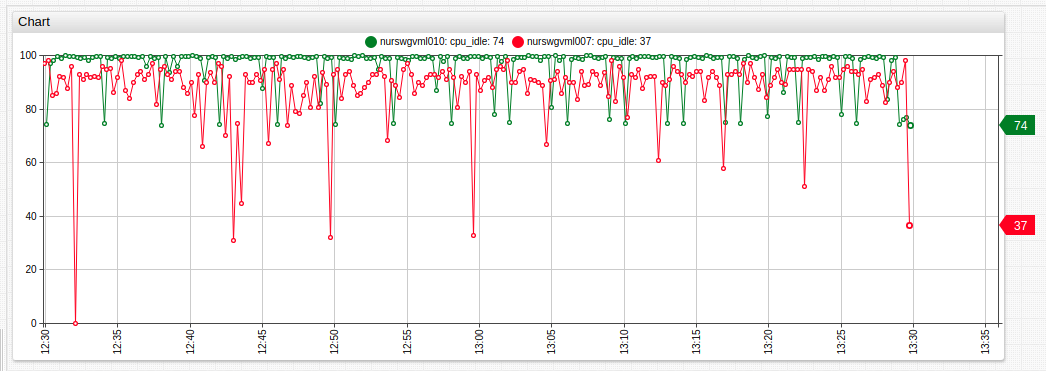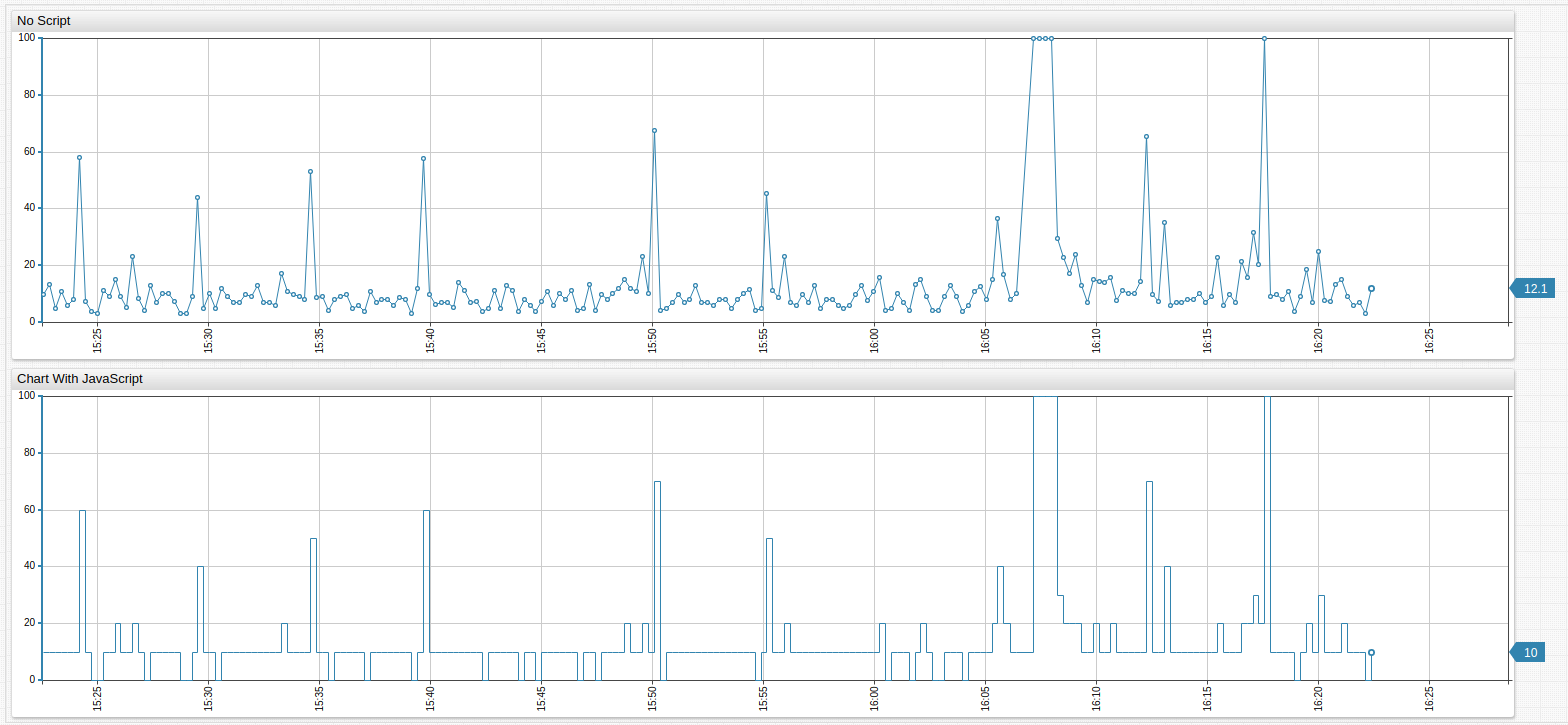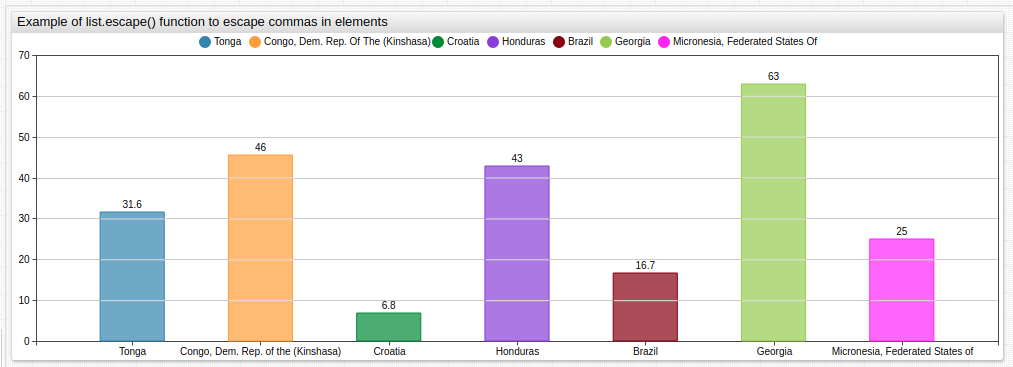Control Structures
The control structures extend the static configuration syntax with variable assignment, conditional branches, iterators, and user-defined functions.
var: assign any object.list: parse string to a list of strings.csv: parse table to a list of objects.for: loop / iterate.if: conditional processing.script: define functions.
var
var assigns an array, object, or function to a variable whose value and fields can be accessed with a placeholder.
If the var assignment occupies one line, closing it with endvar is not required.
The variable must be assigned following the JavaScript syntax, however without the closing semi-colon.
var disks = [[9,2], [9,3], [8,0], [9,0], [9,1], [8,16]]
for di in disks
[series]
[tags]
major = @{di[0]}
minor = @{di[1]}
endfor
# use single or double quotes to assign strings.
# do not close the statement with ;
var tp = "busy"
[series]
entity = nurswgvml006
metric = cpu_@{tp}
Available functions:
The list of entities can be loaded into a var array from the server using the getEntities function.
# Load entity names into an array
var hosts = getEntities('svl-hosts')
# Loop over the 'hosts' array, referring to each element as '@{host}'
for host in hosts
[series]
entity = @{host}
endfor
list
Create a named list of comma-separated elements to iterate through the list with a for loop.
list servers = awsswgvml001, nurswgvml003,
nurswgvml006, nurswgvml007, nurswgvml009
endlist
The elements can be located on multiple lines in which case the list must be closed with the endlist keyword.
If the elements fit on one line, endlist is not required.
list servers = awsswgvml001, nurswgvml003
The list assignment is similar to var. However the var assignment requires the elements to be quoted and enclosed in square brackets.
list servers = awsswgvml001, nurswgvml003
var servers = ['awsswgvml001', 'nurswgvml003']
for
Iterates over a list created with the list command, an array declared with var or specified inline, or variable properties. To access the current element use the @{elementname} placeholder syntax, or in simple cases, @elementname.
Multiple
fororendforloops can be nested.
Create the following visualization which tracks metric cpu_idle for entities nurswgvml010 and nurswgvml007 using either method.

Iterating Over a List:
list servers = nurswgvml010, nurswgvml007
for server in servers
[series]
entity = @{server}
endfor
Iterating Over an Inline Array:
for server in ['nurswgvml010', 'nurswgvml007']
[series]
entity = @{server}
endfor
Iterating Over Object Properties
Order is arbitrary when iterating with the Object.keys() function.
var tags = {
'level': 'ERROR',
'command': 'com.axibase.tsd.Server',
'logger': 'com.axibase.tsd.web.DefaultExceptionHandler'
}
endvar
[widget]
type = chart
[series]
[tags]
for tag_name in Object.keys(tags):
@{tag_name} = @{tags[tag_name]}
endfor
Iterating Over Objects with Named Fields
var servers = [
{'name': 'nurswgvml001', 'networks': ['en3', 'en4']},
{'name': 'nurswgvml002', 'networks': ['en5']}
]
endvar
for server in servers
[widget]
type = box
entity = @{server.name}
metric = network_sent_mb
for net in server.networks
[series]
[tags]
interface = @{net}
endfor
endfor
Iterating Over Object Properties
var servers = {
'nurswgvml001': ['en3', 'en4'],
'nurswgvml002': ['en5']
}
endvar
for server in servers
[widget]
type = box
entity = @{server}
for net in servers[server]
[series]
[tags]
interface = @{net}
endfor
endfor
Iterating Over a Multi-Dimensional Array
var servers = [
['nurswgvml001', ['en3', 'en4']],
['nurswgvml002', ['en5']]
]
endvar
for server in servers
[widget]
type = box
entity = @{server[0]}
metric = network_sent_mb
for net in server[1]
[series]
[tags]
interface = @{net}
endfor
endfor
Insert [group] line for each fourth element in the array
for server in servers
/* add [group] before every 4th element to display 4 widgets per row */
if server_index % 4 == 0
[group]
endif
[widget]
entity = @{server}
endfor
Use the widgets-per-row setting under [group] level to control the number of widgets displayed on each row.
[group]
widgets-per-row = 4
for server in servers
[widget]
entity = @{server}
endfor
Text inside placeholder @{elementname} is evaluated as an expression and can be used for concatenation and formatting.
list servers = 001, 003, 006, 007, 009
for server in servers
[series]
entity = @{'nurswgvml' + server}
endfor
if
Evaluates an expression and prints settings if the expression is true. If the expression returns false, content located within the branch is excluded from widget configuration.
Array elements are accessed in the if or elseif expression by name, not as a placeholder.
for server in servers
[series]
entity = @{server}
if server == 'nurswgvml007'
color = red
elseif server == 'nurswgvml006'
color = green
endif
endfor

script
Include inline JavaScript functions using script syntax.
If script only occupies one line, endscript is not required.
script
window.roundToTen = function (value) {
return Math.round(value / 10) * 10;
}
endscript

range()
Description:
- Generates a regularly spaced array of numbers from
starttoendwith configurablestep.- If
stepis not specified, numbers are sequential. - If
startis greater thanend, numbers are generated in descending order. - If
formatis specified, each number is formatted and converted to a string.
- If
Syntax:
range(start, end, [step], [format])
Returned Value:
Array<number/string>: generates optionally formatted numbers.
Arguments:
| Name | Type | Description |
|---|---|---|
start | number | [Required] First number in list. |
end | number | [Required] Last number in list. |
step | number | Offset between adjacent numbers. |
format | string | Format setting. |
Return sequential numbers from 1 to 10

Syntax:
range(1,10)
Result:
1,2,3,4,5,6,7,8,9,10
Return numbers from 1 to 10 with double step
Syntax:
range(1,10,2)
Result:
1,3,5,7,9
Return numbers from 10 to 1 with a single step
Syntax:
range(10,1)
Result:
10,9,8,7,6,5,4,3,2,1
Return numbers from 10 to 1 with a double step
Syntax:
range(10,1,2)
Result:
10,8,6,4,2
Format sequential numbers 1 to 10 as a percent
Syntax:
range(1,10,'percent')
Result:
1%,2%,3%,4%,5%,6%,7%,8%,9%,10%
Return numbers from 1 to 10 with a double step and format as a percent
Syntax:
range(1,10,2,'percent')
Result:
1%,3%,5%,7%,9%
Format sequential numbers from 1 to 10 as minutes
Syntax:
range(1,10,1,'intervalFormat("%M:%S")(value*1000)')
Result:
00:01,00:02,00:03,00:04,00:05,00:06,00:07,00:08,00:09,00:10
Format sequential numbers from 1 to 12 with an additional fill character (0) for single digit values
Syntax:
range(1, 12, "d3.format('02d')(value)")
Result:
01,02,03,04,05,06,07,08,09,10,11,12
list.escape()
Description:
- Escapes commas for each value in an array of strings.
- The
.escape()method is available in arrays generated from thelistkeyword,varexpression, andcsv.values()method.
Syntax:
list_name.escape()
Returned Value:
Array<string>: An array where commas are escaped for each element. If the argument is not a string the argument is returned unmodified.
Retrieve a list of escaped country names
Countries names are generated from the
list,varandcsv.values()
Apply .escape() to array generated from list

Syntax:
list countries =
Brazil,
Croatia,
Micronesia\, Federated States of,
Georgia,
Tonga,
Honduras,
Congo\, Dem. Rep. of the (Kinshasa)
endlist
country = @{countries.escape()}
Result:
["Brazil","Croatia","Micronesia\\, Federated States of","Georgia","Tonga","Honduras","Liechtenstein","Congo\\, Dem. Rep. of the (Kinshasa)"]
Apply .escape() to the array created in a var expression

Syntax:
var countries = getTags('state.visa-refusal-rate', 'country', 'travel.state.gov')
country = @{countries.escape()}
Result:
[... "Comoros","Congo\\, Dem. Rep. of the (Kinshasa)","Congo\\, Rep. of the (Brazzaville)","Costa Rica","Cote d'Ivoire" ...]
Apply .escape() to the array retrieved by csv.values()

Syntax:
csv countries =
name, value2006
Brazil, 13.2
Croatia, 4.9
"Micronesia, Federated States of", 100
Georgia, 48.2
Tonga, 40.8
Honduras, 38
Liechtenstein, 5.9
"Congo, Dem. Rep. of the (Kinshasa)",44.2
endcsv
country = @{countries.values('name').escape()}
Result:
["Brazil","Congo\\, Dem. Rep. of the (Kinshasa)","Croatia","Georgia","Honduras","Liechtenstein","Micronesia\\, Federated States of","Tonga"]
Troubleshooting
To review the final configuration text after pre-processing, add script = console.log(widgetConfig) anywhere in the widget configuration and review the text via Inspect Element > Console.
script = console.log(widgetConfig)
